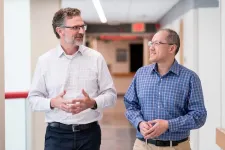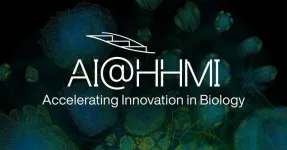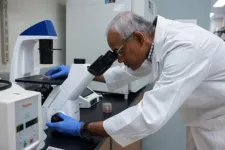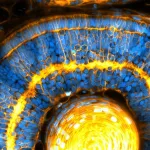(Press-News.org) Scientists from St. Jude Children’s Research Hospital, Seattle Children’s and the Children’s Oncology Group (COG) have identified novel genetic variations that influence relapse risk in children with standard risk B-cell acute lymphoblastic leukemia (SR B-ALL), the most common childhood cancer. The identification of genomic predictors of relapse in SR B-ALL provides a basis for improved diagnosis, precise tailoring of treatment intensity and potentially the development of novel treatment approaches. The study was published today in the Journal of Clinical Oncology.
Standard risk ALL has an excellent prognosis, with remission rates over 90%. However, around 15% of patients who achieve remission later experience a relapse. Previous studies examining genomic alterations to predict relapse risk have primarily focused on high-risk ALL subgroups. SR B-ALL represents a larger group of patients and accounts for approximately half of children with ALL that relapse. This study is one of the first to systematically examine genetic factors on a large scale that influence relapse risk in SR B-ALL.
“ALL, as the most common childhood cancer, is a great success story with over 90% of children cured. But there remains a population of children whose disease is not fully cured, and we've not completely understood why that's the case,” said co-senior author, Charles Mullighan, MBBS (Hons), MSc, MD, St. Jude Comprehensive Cancer Center Deputy Director and Department of Pathology member. “This study focused on that group of poorly understood cases, where we know less about the features that influence the risk of treatment not working and the disease coming back.”
Identifying genetic variations that modulate risk
Genomic profiling identifies specific genetic alterations associated with cancer susceptibility, relapse risk and how tumors respond to therapeutics. These studies allow scientists and clinicians to predict how patients are likely to respond to therapy, providing insights that shape the treatment of childhood ALL. Results from this collaborative study demonstrate the importance of genomic profiling in accurately determining patient risk in B-ALL, in conjunction with traditional criteria.
“We are planning to reduce conventional therapies in the future for children with ALL because we know that many patients can be cured with less therapy,” explained co-senior author, Mignon Loh, MD, leader of Seattle Children’s Cancer and Blood Disorders Center, COG ALL Committee chair emeritus, Seattle Children’s Ben Towne Center for Childhood Cancer Research director, and head of Seattle Children’s Division of Pediatric Hematology, Oncology, Bone Marrow Transplant and Cellular Therapy. “We want to make sure we accurately identify those children, and because of the special design of the study, this project allowed us to do just that.”
The scientists conducted genome and transcriptome sequencing on both SR B-ALL samples that relapsed and samples that remained in complete remission in a one:two ratio. They found that ALL subtypes, genetic alterations and patterns of aneuploidy (extra or missing chromosomes) were associated with the risk of relapse and time to relapse. Some B-ALL subtypes, such as hyperdiploid and ETV6::RUNX1 ALL, had a low frequency of relapse, but others including PAX5-altered, TCF3/4::HLF, ETV6::RUNX1-like and BCR::ABL1-like were associated with an increased risk of relapse. Notably, the specific type of genetic changes within those B-ALL subtypes further influenced the risk of relapse. This work demonstrated that genetic variations and cancer subtypes influence relapse risk in SR B-ALL, and patients classified as standard-risk can have tumors with high-risk features.
“Whole genome sequencing was important to accurately and comprehensively identify these changes, and they could not all have been identified without it,” explained Mullighan. “Children with SR ALL should have their tumor cell genome sequenced upon their initial diagnosis to identify if their tumor cells have these high-risk features, so that their initial therapy intensity can be increased.”
“Beyond conventional therapies, this information could also be used to develop and explore novel, personalized treatment strategies,” added Loh.
Authors and Funding
The study’s co-first authors are Ti-Cheng Chang and Wenan Chen of St. Jude.
The study’s other authors are Mary Shago, University of Toronto; Karen Rabin, Baylor College of Medicine; Elizabeth Raetz, William Carroll, Perlmutter Cancer Center; Anne Angiolillo, Children’s National Medical Center; Michael Borowitz, John Hopkins University; Michael Burke, Medical College of Wisconsin; Andrew Carroll, University of Alabama at Birmingham; I-Ming Chen, Richard Harvey; University of New Mexico, Albuquerque; Nyla Heerema, The Ohio State University; Jeremy Wang, University of North Carolina at Chapel Hill; Eric Larsen, Maine Children’s Cancer Program; Leonard Mattano, HARP Pharma Consulting; Kelly Maloney, University of Colorado; Nilsa Ramirez, Nationwide Children’s Hospital and The Ohio State University; Wanda Salzer, Uniformed Services University; Cheryl Willman, Mayo Clinic; Naomi Winick, University of Texas Southwestern Medical Center; Brent Wood, University of Southern California; Stephen Hunger, Children’s Hospital of Philadelphia and the University of Pennsylvania; and Chunxu Qu, Zhongshan Chen, Dale Hedges, Abdelrahman Elsayed, Stanley Pounds, Meenakshi Devidas, Cheng Cheng, Pradyuamma Baviskar, Ilaria Iacobucci, Sima Jeha, Ching-Hon Pui, and Gang Wu, St. Jude.
The study was supported by the National Institutes of Health (R35 CA197695 and CA21765), the Cancer Moonshot (HHSN261201500003I) and ALSAC, the fundraising awareness organization of St. Jude.
St. Jude Children's Research Hospital
St. Jude Children's Research Hospital is leading the way the world understands, treats and cures childhood cancer, sickle cell disease, and other life-threatening disorders. It is the only National Cancer Institute-designated Comprehensive Cancer Center devoted solely to children. Treatments developed at St. Jude have helped push the overall childhood cancer survival rate from 20% to 80% since the hospital opened more than 60 years ago. St. Jude shares the breakthroughs it makes to help doctors and researchers at local hospitals and cancer centers around the world improve the quality of treatment and care for even more children. To learn more, visit stjude.org, read St. Jude Progress, a digital magazine, and follow St. Jude on social media at @stjuderesearch
Seattle Children’s Hospital
Seattle Children’s mission is to provide hope, care and cures to help every child live the healthiest and most fulfilling life possible. Together, Seattle Children’s Hospital, Research Institute and Foundation deliver superior patient care, identify new discoveries and treatments through pediatric research, and raise funds to create better futures for patients. Ranked as one of the top children’s hospitals in the country by U.S. News & World Report, Seattle Children’s serves as the pediatric and adolescent academic medical center for Washington, Alaska, Montana and Idaho – the largest region of any children’s hospital in the country. As one of the nation’s top five pediatric research centers, Seattle Children’s Research Institute is internationally recognized for its work in neurosciences, immunology, cancer, infectious disease, injury prevention and much more. Seattle Children’s Foundation, along with Seattle Children’s Guild Association – the largest all volunteer fundraising network for any hospital in the country – works with our generous community to raise funds for lifesaving care and research. For more information, visit seattlechildrens.org or follow us on X, Facebook, LinkedIn, Instagram or on our On the Pulse blog.
END
Scientists identify genes linked to relapse in the most common form of childhood leukemia
Researchers identified genetic predictors of relapse in standard risk B-cell acute lymphoblastic leukemia highlighting the role of genetic testing in tailoring therapy.
2024-08-12
ELSE PRESS RELEASES FROM THIS DATE:
Local solvation is decisive for fluorescence of biosensors
2024-08-12
At Ruhr University, the groups of Professor Martina Havenith and Professor Sebastian Kruss collaborated for the study, which took place as part of the Cluster of Excellence “Ruhr Explores Solvation”, RESOLV for short. The PhD students Sanjana Nalige and Phillip Galonska made significant contributions.
Carbon nanotubes as biosensors
Single-walled carbon nanotubes are powerful building blocks for biosensors, as previous studies revealed. Their surface can be chemically tailored with biopolymers or DNA fragments to interact specifically with a certain target molecule. When such molecules bind, the nanotubes change their emission ...
Parents who use humor have better relationships with their children, study finds
2024-08-12
UNIVERSITY PARK, Pa. — They say that laughter is the best medicine, but it could be a good parenting tool too, according to a new study led by researchers from Penn State.
In a pilot study, the research team found that most people viewed humor as an effective parenting tool and that a parent or caregiver’s use of humor affected the quality of their relationship with their children. Among those whose parents used humor, the majority viewed their relationship with their parents and the way they were ...
HHMI invests $500 million in AI-driven life sciences research
2024-08-12
The Howard Hughes Medical Institute today announced AI@HHMI, a $500 million investment over the next 10 years to support artificial intelligence-driven projects in the life sciences. As the largest private biomedical research organization in the United States, HHMI aims to explore the full promise of AI to accelerate scientific discovery at its Janelia Research Campus in Ashburn, Virginia, and at the more than 300 HHMI-affiliated labs.
“By bringing human curiosity and artificial intelligence closer together at every phase of experimentation ...
Locked out of banking: Incarceration is associated with decreased bank account ownership
2024-08-12
People who have served time in jail or prison are less likely to have bank accounts after they are released than they were before serving time, which may hinder their long-term financial security, according to new research.
“Locked out of banking: The limits of financial inclusion for formerly incarcerated individuals” was authored by Brielle Bryan, an assistant professor of sociology at Rice University and J. Michael Collins, a professor of public affairs and human ecology and the Fetzer Family Chair in Consumer and Personal Finance at the University of Wisconsin-Madison. It ...
Research spotlight: Generative AI “drift” and “nondeterminism” inconsistences are important considerations in healthcare applications
2024-08-12
Samuel (Sandy) Aronson, ALM, MA, executive director of IT and AI Solutions for Mass General Brigham Personalized Medicine and senior director of IT and AI Solutions for the Accelerator for Clinical Transformation, is the corresponding author of a paper published in NEJM AI that looked at whether generative AI could hold promise for improving scientific literature review of variants in clinical genetic testing. Their findings could have a wide impact beyond this use case.
How would you summarize your study for a lay audience?
We tested whether ...
Comprehensive atlas of normal breast cells offers new tool for understanding breast cancer origin
2024-08-12
INDIANAPOLIS — Researchers at the Indiana University Melvin and Bren Simon Comprehensive Cancer Center have completed the most extensive mapping of healthy breast cells to date. These findings offer an important tool for researchers at IU and beyond to understand how breast cancer develops and the differences in breast tissue among genetic ancestries.
Published this month in Nature Medicine, researchers developed a comprehensive atlas of breast tissue cells – including details ...
Huang studying electric distribution system protection – Modeling and testing with real-time digital simulator
2024-08-12
Liling Huang, Associate Professor, Department of Electrical and Computer Engineering Dominion Energy Faculty Fellow, received funding for: “Electric Distribution System Protection - Modeling and Testing with Real-Time Digital Simulator.”
Huang will address the complexities of the electric distribution system introduced by Distributed Energy Resources (DERs) through Real-Time Digital Simulator (RTDS) modeling and Hardware-in-the Loop (HIL) simulation to enhance protection system ...
Singh receives funding for AI innovation for economic competitiveness
2024-08-12
JP Singh, Distinguished University Professor, Schar School of Policy and Government, received funding for: “George Mason University Center for AI Innovation for Economic Competitiveness.” He is collaborating on the project with Co-Principal Investigator Amarda Shehu, Associate Vice President of Research, Institute for Digital Innovation, Professor, Computer Science, College of Engineering and Computing (CEC); Jesse Kirkpatrick, Research Associate Professor, Philosophy, College of Humanities and Social Sciences; Acting Director, Institute for Philosophy and Public Policy, Philosophy and Religious Studies; Terry Clower, Northern Virginia Chair in Local ...
Bacteria in lakes fight climate change
2024-08-12
Methane is a potent greenhouse gas frequently produced in the sea and in fresh water. Lakes in particular release large quantities of this climate-killer. Fortunately, however, there are microorganisms that counteract this: They are able to utilize methane to grow and generate energy, thus preventing it from being released into the atmosphere. These microorganisms, known as methanotrophs, are therefore regarded as an important "biological methane filter".
Methanotrophs comprise various groups of microorganisms, and many questions about their way of life have yet to be answered. A study by researchers from the Max Planck Institute for ...
How cell nuclei organize eyes and brain
2024-08-12
(Santa Barbara, Calif.) — In work conducted both at UC Santa Barbara and the Physics of Life Excellence Cluster of TU Dresden, biophysicist Otger Campàs and his research group have found that cell nuclei control the architecture and mechanics of eye and brain tissues during embryonic development. These results add a new role for the cell’s nucleus in tissue organization, well beyond its established role in genetic regulation.
“We were measuring tissue stiffness in the zebrafish retina, and realized that it depended on the packing of nuclei. This was totally unexpected because tissue mechanics is believed to depend on cell surface interactions, but not ...
LAST 30 PRESS RELEASES:
Bis-pseudoindoxyls: a new class of single benzene-based fluorophores for bioimaging applications
Blocking a cancer-related pathway helps reduce spine deformities due to genetic disorder, finds new study
New study explores therapeutic potential of CRISPRCas3 genome-editing system
Korea University researchers revive an abandoned depression drug target using structurally novel NK1 receptor inhibitors
Jeonbuk National University researchers highlight advancements in chemical looping fluidized bed reactors
Tyrannosaurus rex grew up slowly: New study reveals the “king of dinosaurs” kept growing until age 40
Commercial water dispenser machines may contain more contamination than tap water
Death and doctors: New WSU study looks at medical student education on end-of-life care
The best hydrogen for heavy-duty transport is locally produced and green
Pregnancy-related high blood pressure varied among Asian, Pacific Islander subgroups
Measuring movement creates new way to map indoor air pollution
Europe’s crop droughts to get worse even as rain increases
New study identifies signature in blood to better predict type 2 diabetes risk
Research spotlight: developing “smart” nanoparticles to deliver targeted gene therapy in osteoarthritis
A CRISPR fingerprint of pathogenic C. auris fungi
Time warp: How marketers express time can affect what consumers buy
CBD treatment reverses key effects of fetal alcohol spectrum disorder in a mouse model
Blood sugar spikes linked to higher risk of Alzheimer's disease
Staying single for longer affects young people’s well-being
New method allows scientists to 3D-print structures within cells
Screening tool helps identify brain-related comorbidities in individuals with Duchenne muscular dystrophy
How do the active ingredients of monkfruit affect health?
News language and social networks: how do they affect the spread of immigration attitudes?
Researchers discover trigger of tendon disease
Your pet's flea treatment could be destroying the planet
Diabetes risk not associated with timing or type of menopause
Bulk inorganic crystals grown from water emit “handed” light
A new AI-based attack framework advances multi-agent reinforcement learning by amplifying vulnerability and bypassing defenses
While exploring the cosmos, astronauts also fuel explorations of the biology of aging and cellular resilience
Design and synthesis of Zr-IR825 nanoparticles for photothermal therapy of tumor cells
[Press-News.org] Scientists identify genes linked to relapse in the most common form of childhood leukemiaResearchers identified genetic predictors of relapse in standard risk B-cell acute lymphoblastic leukemia highlighting the role of genetic testing in tailoring therapy.





